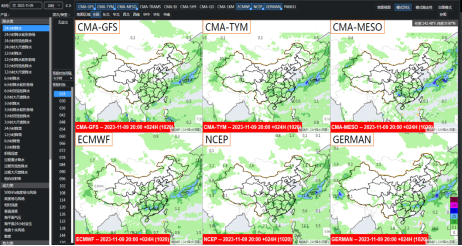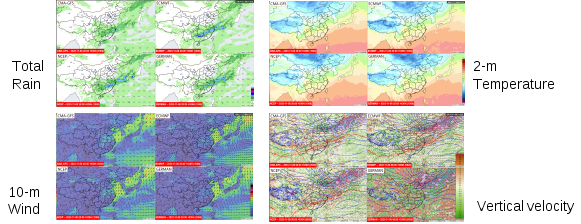Main deliverables and outputs
MMIFA will deliver:
(a) A dedicated web portal for visualizing global NWP data products from WMCs
A dedicated web portal will be implemented to display standardized graphical and/or interactive products based on global deterministic NWP models in WMCs for the RA-II area. The Interactive mode of the web portal will allow users to zoom in to view and analyze details of the products. A concept layout of the MMIFA web portal is shown in Figure 1.
MMIF web portal will be closely linked to WMC Beijing website and will leverage its contributing products for SWFP sub-programmes (SWFP-Southeast Asia, SWFP-Central Asia) and other additional products (e.g. tropical cyclone tracks, Asian sand dust forecast).

Figure 1. A conceptual design of MMIFA web portal
(b) Development of multi-model integrated forecasting products to support severe weather forecasting and early warning
Based on the dedicated web portal, various graphical products of global deterministic NWP core data will be developed with uniform presentation and formats. To support severe weather forecasting e.g. heat/cold wave, variables including maximum / minimum 2-metre temperatures (max 2m-T / min 2m-T), 10-metre wind, relative humidity, temperature at 850/700 hPa may be presented. The intercomparison analysis of multi-model forecasting map-based and location-based vertical profile products with the harmonized presentation format and style is given in Figure 2.


Figure 2. Examples of the multi-model integrated forecasting products
The MMIFA will explore to further develop ensemble forecast products with available global EPS data. For example, products of probabilities (and spread of EPS members) of temperature above/below selected thresholds may be considered to quantify the chance (and uncertainty) of heat/cold wave.
Based on the multiple global deterministic model data and available observations/reanalysis data, multi-model integration / blending forecasting techniques for the weather variables (e.g. total precipitation amount) will be explored with approaches such as frequency matching, and weighted blending. The experimental post-processing products will be developed to improve the quality (e.g. the forecasting skill scores of the Quantitative Precipitation Forecast) and usefulness of the output of the global NWP.
(c) International desk in support of severe weather forecasting using multi-deterministic NWP model products
International training activities targeted for operational forecasters in WMO RA-II members especially LDCs Member will be organized on interpreting and utilizing the outputs of multi-model prediction. Applications of available global deterministic NWP and global EPS data product and multi-model integrated products will be exemplified for prediction of severe weather events among the RA-II members, including verification of multi-model integrated products, as well as limitations on forecast skill and predictability, etc.
 京公网安备 11040102700102号
京公网安备 11040102700102号